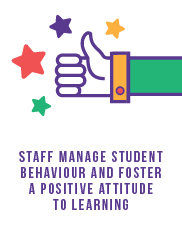Behaviour for Learning
Each week in Connect, Mark and Jo will be sharing behaviour for learning tips designed to help manage behaviour in the unusual circumstances of Covid-19.
Behaviour for Learning tip #7: Motivation and Engagement

Understandably, a number of our students are struggling with motivation during this lockdown. Although we can’t recreate quite the same sort of interactions online compared to in the classroom, there are some basic principles that will help.
Online teaching can be nerve-wracking for a lot of teachers! Remember to express joy and excitement as you interact with your class. Telling jokes, pointing out beautiful moments, silly things, or even just smiling when you greet your class in the morning. The more fun you’re having, the more engaged your students will be.
Enthusiasm will continue to promote positive relationships throughout the school year, even if our day-to-day isn’t consistent. Now more than ever, it’s so important to be that model for students of how we can positively cope through challenging times. Here are some ways that you can do that:
1. Praise students who display the behaviour you want. By praising them and saying specifically what it’s for then it not only boosts those students’ self-esteem but reinforces positive behaviour with your attention. For example, if you congratulate two of your students for responding to questions in full sentences then it will encourage others to do so as well. This is a great way to direct your attention and build relationships.
2. Slowly build up the commands you want students to follow. Start by praising small directions that are followed and then build up the challenge. For example, you may have a student who doesn’t submit work. Firstly, you provide one or two direct commands where compliance is likely and then build up the commands.
“Put your hand up if you are here today when I call the register.”
“In the chat, write an answer to one question.” Then you can move on…
“Complete question 1 on the Google Doc we are working on.”
3. Give lots of opportunities for students to respond. Keep a quick pace and plan for lots of verbal and nonverbal engagement as this will increase student attention and consequently, more on-task behaviour and overall engagement.
This could look like:
- Using the raised hand function in Google Meet
- Students use the chat to give a thumbs up or down
- Get students to write their answers on a mini-virtual-whiteboard
- Break down more complex questions and allow multiple students to answer different parts (you could use the break-out rooms to do this
All of these strategies will give you lots of opportunities for students to respond and succeed, whilst giving you a lot of opportunities to reinforce positive behaviour!
Mark and Jo